|
Aptera 2 Series
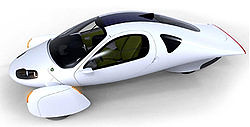
Preproduction Aptera 2e |
| Manufacturer |
Aptera Motors, Inc. |
| Production |
2009 (planned) |
| Assembly |
United States |
| Predecessor |
Aptera Mk-1 |
| Class |
Subcompact |
| Body style(s) |
2-door three wheeled car |
| Layout |
Front-engine, front-wheel drive layout |
| Engine(s) |
2e: Electric motor
2h: Gasoline generator |
| Transmission(s) |
2e: Gear box 10:1 ratio
2h: Series hybrid layout |
| Wheelbase |
111 in (282 cm) |
| Length |
173 in (439 cm) |
| Width |
91 in (231 cm) |
| Height |
53 in (135 cm) |
| Curb weight |
1,500 lb (680 kg) |
| Fuel capacity |
2e:10-13 kWh Lithium iron phosphate battery
2h:5 gallons |
| Electric range |
2e: 100 mi (160 km)
2h: 60 mi (100 km) |
| Designer |
Eleven |
Design and fuel consumption:
The Aptera 2 Series is expected to consume 96 watt-hours/mi, making it a low
energy vehicle. The Aptera 2 Series has a drag coefficient of 0.15, compared
with 0.19 for the record-holding EV1. Its atypical shape is a result of
extensive optimization in a virtual wind tunnel. It uses recessed windshield
wipers and low rolling resistance tires. The Mk-1 prototype used
“Eyes-Forward” cameras exclusively instead of high-drag mirrors, but this
concept appears to have been abandoned, possibly due to the fact that
California Vehicle Code mandates having at least one outside mirror;
September 2008 Aptera newsletter showed a rendering of the Aptera 2e with a
conventional driver-side rear-view mirror and no driver-side camera. Fambro
has stated that the system was simplified to a single camera mounted near
the top of the vehicle.
The body design is similar to the human-powered ‘Pegasus’ and ‘Fusion’
vehicles and the MIT Aztec, but the direct inspiration was the Volkswagen
1-litre car.
The Aptera 2 Series is a three-wheeled vehicle. On the Mk-1 prototype, the
two front wheels steer, and the rear wheel is belt-driven by the electric
motor. However, the latest design renderings appear to feature front-wheel
driveshafts and CV boots.
Aptera's December newsletter confirmed the shift to front-wheel drive.
Aptera Motors uses composites in its construction, both to reduce weight and
allow the unconventional body shape. This would normally be prohibitively
expensive, but their Panelized Automated Composite Construction (PAC2)
process fully automates the manufacture of the composite body.[citation
needed]
The battery will also be paired with supercapacitors for acceleration and
braking.
Plug-in Series Hybrid:
An early Aptera 2h design used a “small, water-cooled EFI Gasoline engine
with closed loop oxygen feedback and catalytic converter,” coupled with a 12
kW generator/starter. With a tank capacity of “up to five gallons,” the
Aptera 2h would have a claimed range of 600 to 700 mi (970 to 1,130 km),
compared to the 120 miles (190 km) range of the Aptera 2e. The 2h will be a
series hybrid: the engine would not be connected to the drivetrain; instead,
it would be used to recharge the batteries.
As with any plug-in hybrid, fuel economy of the Aptera 2h depends on trip
length and battery charge. For trips of less than about 50 miles (80 km)
after a full charge the engine may not turn on at all, resulting in
approximately the same energy consumption as the pure electric model: 96
watt-hours/mi. If on the other hand the car was never plugged in, the Aptera
2h would get 130 miles per US gallon (1.8 l/100 km). Aptera Motors quotes
300 miles per US gallon (0.8 l/100 km), which applies to a 120 mile trip
after a full charge. They justify this by stating that 99% of Americans
drive less than 120 miles daily.
Safety:
Because the Aptera 2 Series has only three wheels, most states in the US
classify the vehicle as a motorcycle. This means that safety and emissions
tests are not mandatory, as they are for automobiles.
Despite this, Aptera Motors has emphasized that safety has a high design
priority. Aptera Motors has performed simulated crash tests using ABAQUS FEA
software, crush testing on structural components, and is planning real-world
crash tests before production. The Aptera 2e features a Formula One-inspired
passenger safety cell and boxed sandwich foam core composite structures.
Frontal crumple distance is 45 inches (114 cm), large for a vehicle of its
size. As the body is above most car’s bumpers, a colliding vehicle’s bumper
will travel under the body, deflecting the energy. Despite its height, the
placement of the heavy batteries lowers the center-of-mass of the Aptera 2
Series, a design similar to the highly stable Commuter Cars Tango. Driver
and passenger airbag-in-seatbelts are also provided.
Accessories and interior:
The release model, announced in September 2007, seats 2 adults with a child
seat optionally between them, and has 15.9 cubic feet (450 L) of cargo
capacity, enough for a couple of surfboards. It will use LED running and
interior lights to reduce power. A solar panel mounted on the roof runs the
heat pump during the day. This keeps the interior comfortable and reduces
the size of the heat pump needed. The seats can be heated or cooled by
forced air, both for comfort and efficiency reasons. The only comfort
downside is that the rear wheel transmits every bump. While absent on
current prototypes, the production Aptera 2e will have windows that open.
Radio, CD/DVD/MP3 player, and GPS navigation are integrated into an
in-console touch screen StreetDeck-based carputer, but the climate control
uses physical dials. It will also have RFID-based keyless ignition and entry
and scarab doors.
To reduce the ecological footprint of construction, EcoSpun recycled
materials and organic dyes will be used for the seats and flooring, and the
dashboard and the door panels are free of heavy metals and plasticizers.
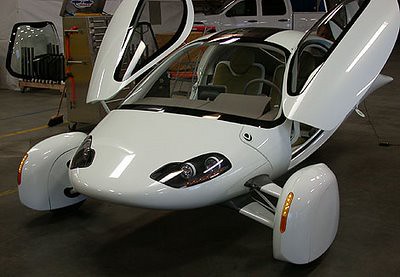
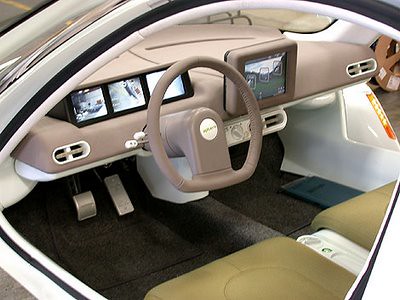
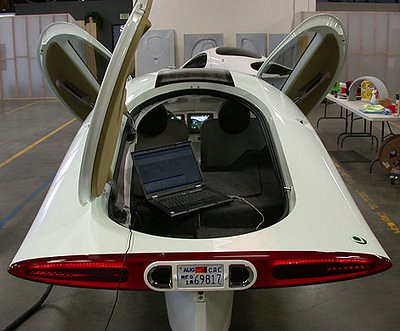
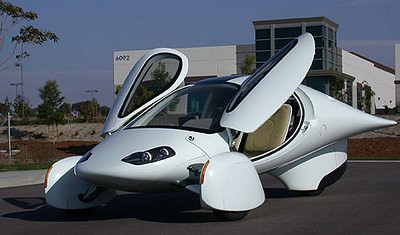
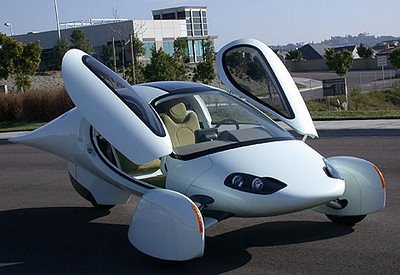

 visitor
visitor
No comments:
Post a Comment